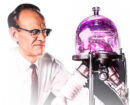Unfortunately, he discovered it at the National Ignition Facility, where they can spend tens of millions of dollars on a single burst of fusion produced by a finely-tune array of nearly 200 laser beams:
But what if this time is different? What if a laser-powered fusion energy power plant that would have all the reliability of coal, without the carbon dioxide, all the cleanliness of wind and solar, without having to worry about the sun not shining or the wind not blowing, and all the scale of nuclear, without all the waste, was indeed just 10 years away or less? That would be a holy cow game-changer.
Tom, do you want a REALLY "holy cow game-changer"? Then how about a process that produces real, hot, "thermonuclear" fusion in a device you can build in your own basement or garage? Instead of a facility the size of an auto factory, costing tens of millions — if not hundreds, or billions — of dollars, suppose fusion could be achieved in a device that costs about as much as a good set of used golf clubs?
It's possible, and in fact it's being done almost every day in a device first demonstrated more than 40 years ago by electronic video pioneer Philo T. Farnsworth — as described in my book, The Boy Who Invented Television.
Admittedly, the process we're talking about here — the Farnsworth fusor — produces no more "energy gain" (we call it "break-even," Tom) than that behemoth in California that you found so impressive and promising.
But if it's a real "paradigm shift" you want in the way the world produces energy — clean, (relatively) safe and virtually unlimited energy — then what could be more promising than a machine that occupies about as much space as a microwave oven?
And what could be more exciting than a process that is being effectively explored on a grassroots level by dozens of people around the world who are producing fusion in their own basements and garages — and then comparing their results and sharing data with their colleagues around the world via the Internet?
Now, there's a really interesting prospect: instead of holding out for a future where energy production continues to be controlled by large and well-capitalized industrial interests, suppose we could all produce more clean energy than we could ever possibly use. And do it right in our own basements from a benign fusion energy device — a gadget that would occupy the same space our oil, gas, or coal burning furnace occupies now?
That was the vision articulated by Philo T. Farnsworth when he first developed the Fusor in the 1960s. And while anybody building a Fusor today will tell you that they are many orders of magnitude from anything approaching "break even" or net energy production, the effort is worth noting, because dollar for dollar, the Farnsworth approach is producing vastly more amounts of actual fusion than the immensely complicated devices like you toured at the National Ignition Facility.
In your op-ed piece, Friedman concludes:
game-changers. I am talking about systems that could give us abundant,
clean, reliable electrons and drive
massive innovation in big lasers, materials science, nuclear physics
and chemistry that would benefit, energize and renew many U.S.
industries.
And I agree, we need to make a few big bets. But we also need to make a few SMALL bets, and stop looking toward gigantic institutions to deliver the solutions we need if they can perhaps be delivered instead on an entirely different scale.
